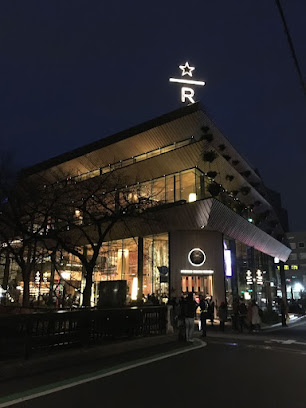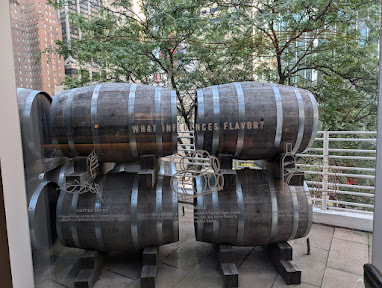Introduction
How would Asia's Biggest Starbucks Reserve Roastery hold against the World's Biggest Equivalent? Right after my A levels back in 2019, I decided to travel with some friends to Tokyo Japan, for our Graduation Trip.
Part of our itinerary then was to visit Asia's Biggest Starbucks Roastery in Tokyo Japan, near the Shibuya area. After experiencing such, while in Chicago during my Global Exchange Independent Study Module, I wanted to check out what the World's Biggest Starbucks Roastery has to offer.
For the uninitiated, Starbucks Reserve Roasteries are physical locations where Starbucks Master Roasters tailor unique roasts for each lot to enhance the flavor and nuances of each coffee. The Starbucks Reserve Program began as a way to compete in the high-end coffee market, where customers find themselves amidst a new selection of coffee options, different from the standard Starbucks menu items.
Don't forget to view their specialized menu prior to ordering!
Cameras Used:
Tokyo Starbucks Roastery: Apple iPhone 6s (2019)
Tokyo Starbucks Roastery: Apple iPhone 6s (2019)
Chicago Starbucks Roastery: Google Pixel 8 Pro (2024)
Tokyo, Japan (2019)
Braving the cold Japanese winter night was not a normal experience for us Singaporean travelers who used to bask in the warm, humid, tropical night. Such a visit was a target for one of us four, with two others quickly deciding to head back to our hotel after a long day's trip. I, on the other hand, decided to stay with that friend, to experience what my family would not normally do, and to have my firsthand experience of what a major Starbucks Roastery was like.
A major event that my friend emphasized was to view the crossing nearby, intersecting Meguro-dori and Naka-Meguro-dori, from the Tokyo Roastery, which is located in the Naka-Meguro Neighbourhood.
Through the dark winter night, viewing the star that's underscored with an R was nothing short of beautiful. Knowing the warmth of a hot premium coffee is what most would look forward to, in such harsh conditions.
Tokyo Starbucks Roastery at Night
After a relatively long period (about 1 hour or so), our queue number was called, and we were finally admitted. We were greeted by the impressive cold brew section, showcasing Starbucks' dedication to artisanal coffee brewing. The mesmerizing sight of cold brew towers, meticulously prepared drinks, and the aroma of freshly brewed coffee set the tone for our visit.
Cold Brew Section of Tokyo Starbucks Roastery
From there, we explored upwards, viewing the huge contraptions all around. No wonder it was often described as a "theme park experience"! The towering coffee silos, elaborate brewing equipment, and the sight of the coffee beans journeying through transparent tubes were fascinating.
Engineering Marvel (Roaster) at Tokyo Starbucks Roastery
Each level of the roastery offered a new discovery, from the Reserve coffee bar to the Italian-inspired Princi bakery, where the aroma of freshly baked goods was irresistible.
Starbucks Roastery Bakery
As someone's first impression, I was rather amazed by what Starbucks could come up with, especially with all the differing sections, ranging from the previously mentioned Italian-inspired Princi bakery to a Reserve Arriviamo Bar. Such stores are not something I would expect to see in a Starbucks building!
Tokyo Roastery Arriviamo Bar
Adding to the richness of the experience were the walls adorned with various coffee information cards, explaining the differing types of coffee beans. These cards offered fascinating insights into the origin, flavor profiles, and unique characteristics of each coffee variety, further enhancing the educational aspect of the visit.
Diverse Coffee Origins Wall at Tokyo Roastery
Nothing could complete the Starbucks Reserve experience other than savouring one of their own speciality coffee. Among their menu that I have not seen before (as it differs from the regular Starbucks menu), I've decided to try their Decaf Costa Rica Hacienda Alsacia coffee. In particular, I looked for the decaffinated variant as it was relatively late in the day (around 7.30pm), with my body being especially susceptible to the effects of caffeine. The rich, nuanced flavors allowed me to fully enjoy the experience without the worry of disrupting my sleep.
Decaf Costa Rica Hacienda Alsacia Coffee with Heart Latte Art
While at Starbucks Reserve Tokyo, I noticed the coffee information card was written in Japanese. Determined to unlock the hidden details, I turned to Google Translate to break down the language barrier and reveal the intriguing story behind the brew. Looking back, keeping a picture of the original Japanese writing could've contributed to its authenticity, when viewing past experiences.
English Translated Japanese Decaf Costa Rica Hacienda Alsacia Coffee Information Card
Overall, the experience was just as I had imagined: sipping a warm cup of coffee on a cold winter night, soaking in the hustle and bustle of Starbucks Reserve customers as they admired the various coffee brewing equipment on display. Although it took some time to find an optimal seat with a view of the crossing, the wait was well worth it. I highly recommend visiting Starbucks Reserve for this unique experience, even for those who are not avid coffee drinkers.
Chicago, United States of America (2024)
It was near the end of my month-long travel to Chicago for my independent study module where I took notice of the presence of not just a Starbucks Reserve, but the largest Starbucks Reserve Roastery in the world. Chicago just has that many attractions and activities for travellers to experience!
As my friends were looking to make some last minute shopping, I decided to take some time off to visit the Starbucks Reserve myself, to relieve my previous experience, and to view the differences between the biggest Starbucks Reserve in Asia, and the largest variant in the World.
Upon arriving at the Chicago Starbucks Roastery, I noticed the long queues within the Roastery itself, a contrast to the separate section provided at the Tokyo Starbucks Roastery. What greeted me were a couple of cozy heated radiators at the entrance, allowing visitors to view the flames through the mesh. The ambiance created by these structures would have been perfect on a cold winter night, although I visited in the middle of a summer day. Nonetheless, it added to the atmosphere, clearly marking the entrance of the Chicago Starbucks Reserve and distinguishing it from the surrounding Chicago streets.
Fiery Radiators at the Entrance of the Chicago Starbucks Reserve Roastery
Among all the merchandise and activities on the first floor (at the entrance), what captured my attention the most was the 56-foot cask, surrounded by a spiraling escalator—a unique invention I had never seen before. With little convincing, I decided to take the escalator up to get a rough overview of what each floor had to offer before grabbing a drink and checking out the merchandise.
Spiraling Escalator Around the Central Golden Cask at Chicago Starbucks Reserve
Central Golden Cask viewed from the Bottom at Starbucks Reserve Chicago
Similar to the Tokyo Starbucks Reserve Roastery, the Chicago Starbucks Reserve Roastery showcases an Italian-inspired Princi Bakery. Alongside the bakery, there are coffee bars that feature various smaller roasteries for specific beans, offering a unique and tailored experience.
Modern Coffee Bar and Princi Bakery at Chicago Starbucks Roastery
Taps overlooking Spirit Bar
Parked outside the window, overlooking the Magnificent Mile, visitors can see Chicago Roastery's signature whiskey barrels used for their Whiskey Barrel-Aged Coffee. The barrels, sourced from Knob Creek Bourbon in Kentucky, are paired with Guatemalan beans to create a rich blend of coffee and whiskey. This unique concoction is served iced, delighting and intriguing guests.
Whiskey Barrels Display at Starbucks Reserve Chicago
On the same floor, you can catch a glimpse of the 56-foot cask, looking down towards the spiraling view that includes part of the spiral escalator in sight.
View from Above: Cask and Spiral Escalator at Starbucks Reserve Chicago
Starbucks Reserve Logo on Top of Cask at Chicago Roastery
The Chicago Roastery features a rooftop terrace with a stunning view of Michigan Avenue, accessible to the public when not booked for events. Before stepping out, visitors can also peer down into the interior of the Roastery, catching glimpses of each floor on the way down.
Rooftop Terrace View of Michigan Avenue at Starbucks Reserve Chicago
Interior View of Chicago Starbucks Reserve Roastery from Above
With all that in mind, I decided to sit down for a drink and a bite, opting for Chicago's signature Whiskey Barrel-Aged Cold Brew and a Tropical Coconut Mousse Cake. Before ordering, I asked the staff about the alcohol content of the Whiskey Barrel-Aged Cold Brew and learned that it contains 0% alcohol. In a funny turn of events, I inquired if there was a decaffeinated variant, but unfortunately, there wasn't. Nonetheless, I decided to take the plunge since this was a unique opportunity I might not encounter again, and with an additional night in Chicago, I felt it was safe to indulge in their signature drink and enjoy my last few moments in the city.
Chicago's Signature Whiskey Barrel-Aged Cold Brew and Tropical Coconut Mousse Cake
In my opinion, the Tropical Coconut Mousse Cake from Starbucks' Princi Desserts paired fantastically with their Whiskey Barrel-Aged Cold Brew. The soft, sweet simplicity of the coconut almond cake, matched the mellow yet complex favours the cold brew has to provide. I decided that consuming the cake alongside the cold brew works best prior to finishing up what was left of the cold brew, from embellishing in the sweetness of the coconut almond cake to being engulfed in the complexities of the cold brew.
With that, I was able to ask and attained another one of Starbucks Roastery's signature coffee information card, to remember and educate myself about the various coffees they have to offer.
Front of Starbucks Whiskey Barrel-Aged Cold Brew Information Card
That, along with quickly picking up some merchandise (postcards) for a friend, which sadly were not photographed, marked the end of my wonderful experience at the world's largest Starbucks Roastery.
Comparing the two experiences is tough. Tokyo's Roastery was my first ever, where I enjoyed a warm coffee in a modern setting on a winter night. In contrast, Chicago's experience involved a cool and unique drink on a warm summer day. If I were to return to Tokyo's Roastery, I would try one of their signature drinks. However, the experience might not be as magical, as Japan has its own twist on franchises, blending cultural nuances and palatable offerings, which could overshadow the unique Starbucks experience. With this in mind, the Chicago Roastery did not disappoint, offering a uniquely American twist with their bourbon barrels, while still presenting globally accepted coffee.
Milan, Italy (2024?)
With that said, a missed opportunity arose when I traveled to Milan earlier this year. I was disappointed by the lack of activities, having arrived on a Monday. Although I visited the Duomo and Galleria, I still had more than half a day to explore the first European city I traveled to during my exchange. In hindsight, rather than spending on a lackluster museum and food (although the food in Milan is incomparable), if I had known about the only European Starbucks being there, I would have made an effort to check out Europe's variant.
























No comments:
Post a Comment